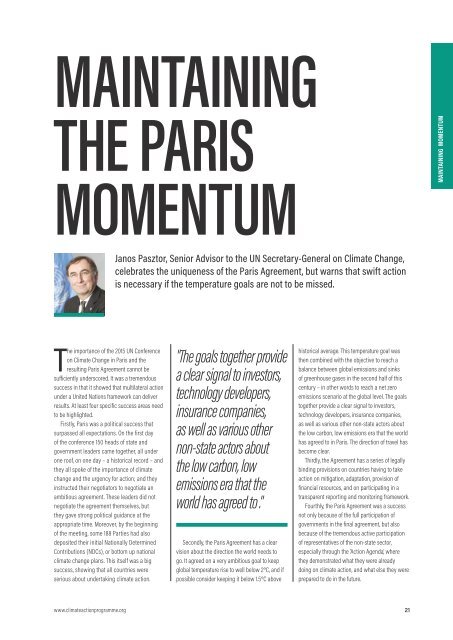Climate Action 2016-2017
Create successful ePaper yourself
Turn your PDF publications into a flip-book with our unique Google optimized e-Paper software.
MAINTAINING<br />
THE PARIS<br />
MOMENTUM<br />
MAINTAINING MOMENTUM<br />
Janos Pasztor, Senior Advisor to the UN Secretary-General on <strong>Climate</strong> Change,<br />
celebrates the uniqueness of the Paris Agreement, but warns that swift action<br />
is necessary if the temperature goals are not to be missed.<br />
The importance of the 2015 UN Conference<br />
on <strong>Climate</strong> Change in Paris and the<br />
resulting Paris Agreement cannot be<br />
sufficiently underscored. It was a tremendous<br />
success in that it showed that multilateral action<br />
under a United Nations framework can deliver<br />
results. At least four specific success areas need<br />
to be highlighted.<br />
Firstly, Paris was a political success that<br />
surpassed all expectations. On the first day<br />
of the conference 150 heads of state and<br />
government leaders came together, all under<br />
one roof, on one day – a historical record – and<br />
they all spoke of the importance of climate<br />
change and the urgency for action; and they<br />
instructed their negotiators to negotiate an<br />
ambitious agreement. These leaders did not<br />
negotiate the agreement themselves, but<br />
they gave strong political guidance at the<br />
appropriate time. Moreover, by the beginning<br />
of the meeting, some 188 Parties had also<br />
deposited their initial Nationally Determined<br />
Contributions (NDCs), or bottom up national<br />
climate change plans. This itself was a big<br />
success, showing that all countries were<br />
serious about undertaking climate action.<br />
"The goals together provide<br />
a clear signal to investors,<br />
technology developers,<br />
insurance companies,<br />
as well as various other<br />
non-state actors about<br />
the low carbon, low<br />
emissions era that the<br />
world has agreed to ."<br />
Secondly, the Paris Agreement has a clear<br />
vision about the direction the world needs to<br />
go. It agreed on a very ambitious goal to keep<br />
global temperature rise to well below 2°C, and if<br />
possible consider keeping it below 1.5°C above<br />
historical average. This temperature goal was<br />
then combined with the objective to reach a<br />
balance between global emissions and sinks<br />
of greenhouse gases in the second half of this<br />
century – in other words to reach a net zero<br />
emissions scenario at the global level. The goals<br />
together provide a clear signal to investors,<br />
technology developers, insurance companies,<br />
as well as various other non-state actors about<br />
the low carbon, low emissions era that the world<br />
has agreed to in Paris. The direction of travel has<br />
become clear.<br />
Thirdly, the Agreement has a series of legally<br />
binding provisions on countries having to take<br />
action on mitigation, adaptation, provision of<br />
financial resources, and on participating in a<br />
transparent reporting and monitoring framework.<br />
Fourthly, the Paris Agreement was a success<br />
not only because of the full participation of<br />
governments in the final agreement, but also<br />
because of the tremendous active participation<br />
of representatives of the non-state sector,<br />
especially through the ‘<strong>Action</strong> Agenda’, where<br />
they demonstrated what they were already<br />
doing on climate action, and what else they were<br />
prepared to do in the future.<br />
www.climateactionprogramme.org 21












